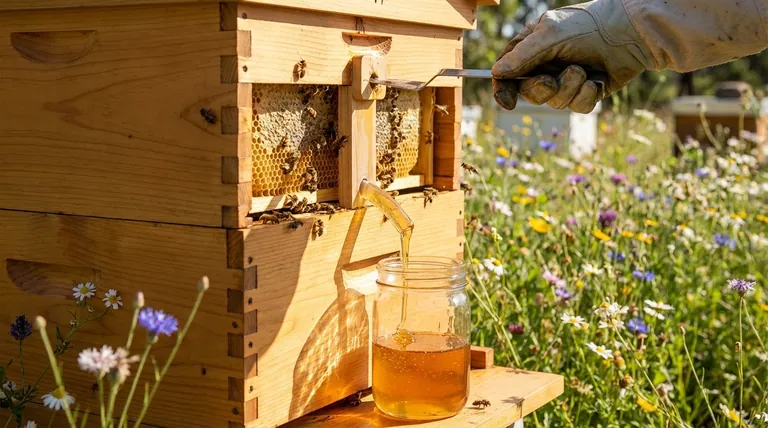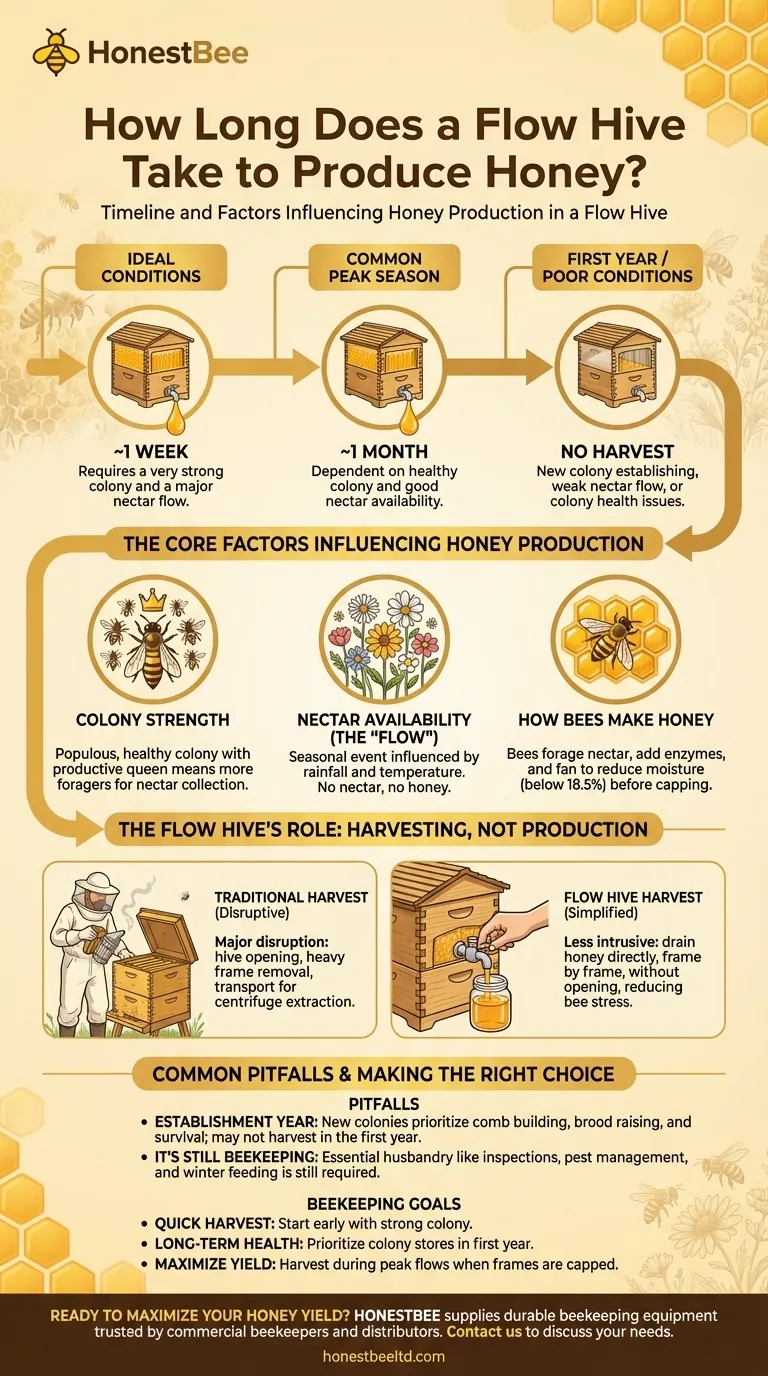In ideal conditions, a Flow Hive super can fill with honey in as little as one week. However, a more realistic and common timeframe during the peak flowering season of spring and summer is within one month. The actual speed is entirely dependent on the strength of your bee colony and the availability of local nectar sources.
The critical point to understand is that the Flow Hive does not make bees produce honey faster. Instead, it revolutionizes the harvesting process. The time it takes to get honey is governed by the bees and their environment, not the equipment itself.

The Core Factors Influencing Honey Production
The timeline for filling a honey super is a function of nature, not technology. Several key variables are at play, and the Flow Hive is subject to them just like any traditional hive.
The Strength of Your Colony
A large, populous, and healthy colony with a productive queen will have a significant workforce of forager bees. More foragers mean more nectar can be collected each day, leading directly to faster honey production.
The Availability of Nectar (The "Flow")
This is the single most important factor. Honey production is only possible when there is a nectar flow, which is when local plants are flowering and producing abundant nectar. This is a seasonal event that can be influenced by rainfall and temperature. A weak flow means slow production, regardless of hive type.
How Bees Make Honey
Bees are the true producers. They forage for nectar, bring it back to the hive, and mix it with an enzyme called invertase. They then store this mixture in honeycomb cells and fan it with their wings to reduce the moisture content. Once the water level is below about 18.5%, they cap the cell with beeswax, and only then is it officially honey.
The Flow Hive's Role: Harvesting, Not Production
The innovation of the Flow Hive is not in bee biology but in beekeeper convenience. It streamlines the extraction of honey, making it less disruptive and labor-intensive.
A Less Intrusive Harvest
With a traditional hive, harvesting requires opening the hive, smoking the bees, removing heavy frames, and transporting them to a separate location for extraction with a centrifuge. This is a major disruption.
A Simplified Process
The Flow Hive allows you to drain honey directly from the hive, frame by frame, without opening it. This process is far less stressful for the bees, who can continue their work largely uninterrupted. This ease of use is what makes it highly appealing to hobbyists and backyard beekeepers.
Common Pitfalls to Avoid
While the harvesting process is simple, the beekeeping itself is not. New beekeepers, in particular, must set realistic expectations.
The Establishment Year
A brand-new colony has an immense amount of work to do before it can create surplus honey for you. Its priorities are building wax comb, raising a new generation of bees (brood), and storing enough honey and pollen for its own survival. Many beekeepers do not get a harvest in their very first year.
It's Still Beekeeping
The Flow Hive does not eliminate the need for essential bee husbandry. You must still perform regular hive inspections to check on the queen, monitor for pests like Varroa mites, and ensure the colony has enough food to survive through winter. The hive is a tool; it does not replace the skill of the beekeeper.
Making the Right Choice for Your Goal
Your approach to harvesting should align with your primary beekeeping goals, especially in the first couple of years.
- If your primary focus is a quick first harvest: Start with a strong, established colony early in the spring to give them the maximum amount of time during the main nectar flow.
- If your primary focus is long-term hive health: Prioritize letting the bees build their own food stores in the first year, harvesting only what is clearly a surplus late in the season.
- If your primary focus is maximizing yield: Learn to identify the peak nectar flows in your specific area and be prepared to harvest as soon as frames are full and capped to provide the bees with more space.
Ultimately, successful honey production is a partnership between a healthy colony, a thriving environment, and an observant beekeeper.
Summary Table:
| Timeframe | Conditions | Key Factors |
|---|---|---|
| ~1 Week | Ideal Conditions | Very strong colony, major nectar flow |
| ~1 Month | Common Peak Season | Healthy colony, good nectar availability |
| No Harvest | First Year / Poor Conditions | New colony establishing, weak nectar flow, colony health issues |
Ready to maximize your honey yield?
Whether you're a commercial apiary looking to scale operations or a distributor seeking reliable equipment, the right tools are essential for success. The Flow Hive simplifies harvesting, but a healthy colony and proper management are the true keys to production.
HONESTBEE supplies the durable beekeeping supplies and equipment that commercial beekeepers and distributors trust. From hive components to protective gear, we support your operations with wholesale-focused solutions that promote colony health and efficiency.
Contact our team today to discuss your specific needs and how our products can help you build a more productive and profitable beekeeping business.
Visual Guide

Related Products
- HONESTBEE Professional Long Handled Hive Tool with Precision Cutting Blade
- Professional Dual-End Stainless Steel Hive Tool for Beekeeping
- Professional Multi-Function Stainless Steel Hive Tool
- Professional Grade Foldable Beehive Handles
- Professional Engraved Round Hive Number Tags for Beekeeping
People Also Ask
- What tools are used for cleaning frames? A Beekeeper's Simple 4-Tool Guide
- What is a hive tool used for in beekeeping? Your Essential Guide to Hive Management
- What are the basic tools for beekeeping? Essential Starter Kit for Safe & Successful Hive Management
- Why do hive tools have a hole? Unlock the Secret to Efficient Beekeeping
- What is a hive tool and what are its uses? Master Your Hive Inspections with the Essential Beekeeper's Tool



















